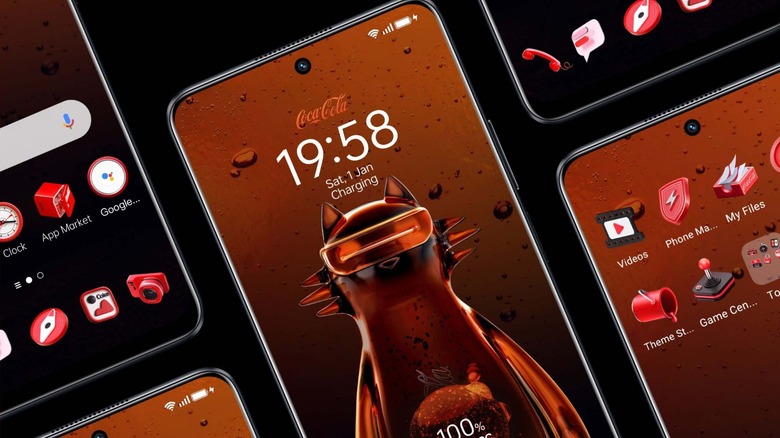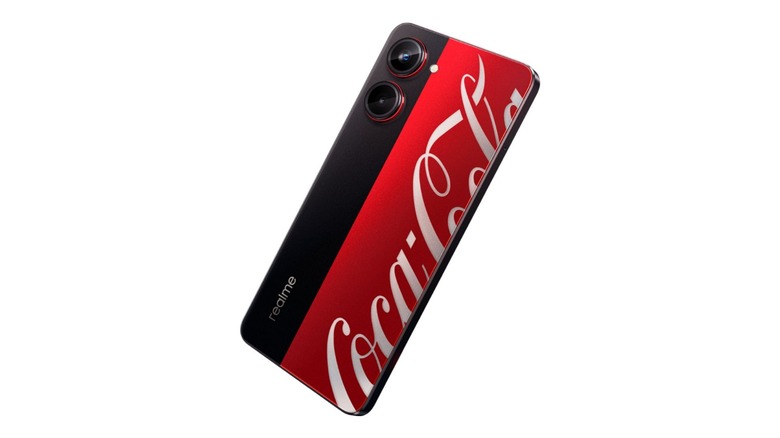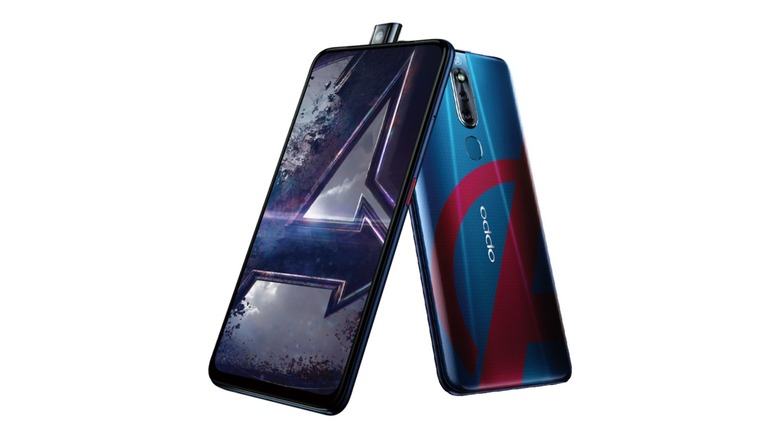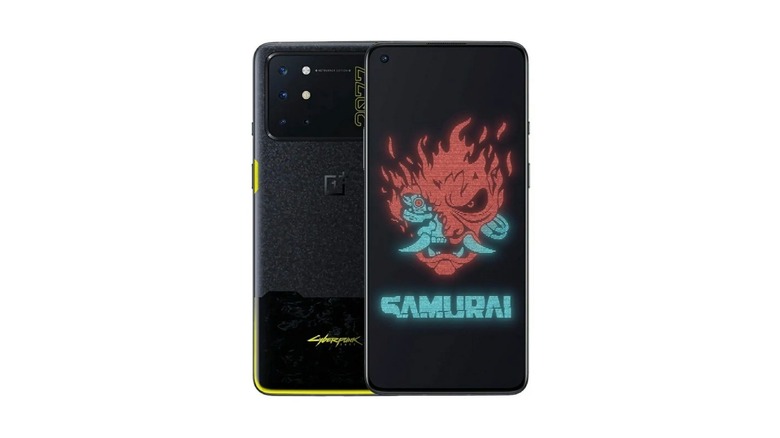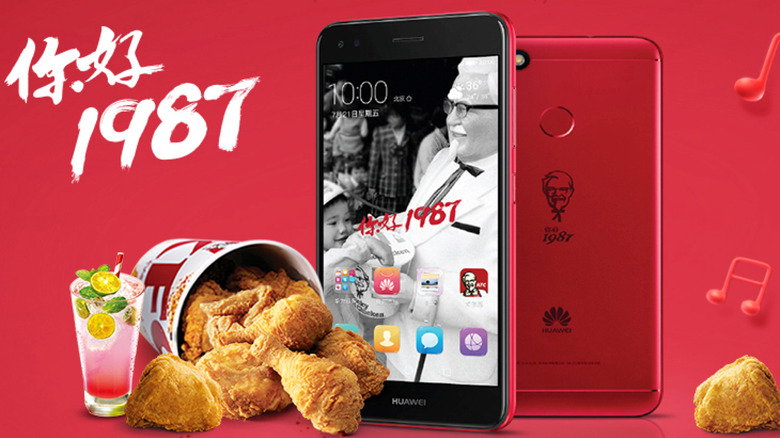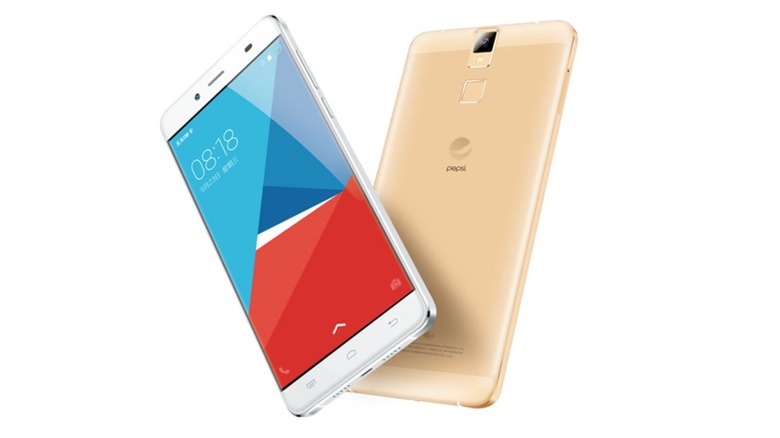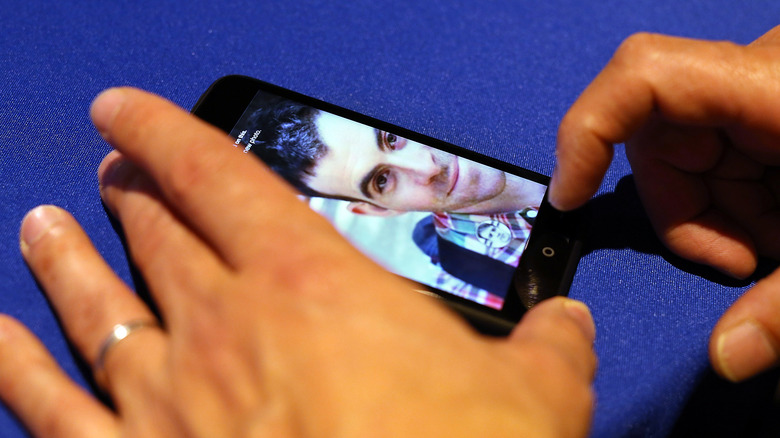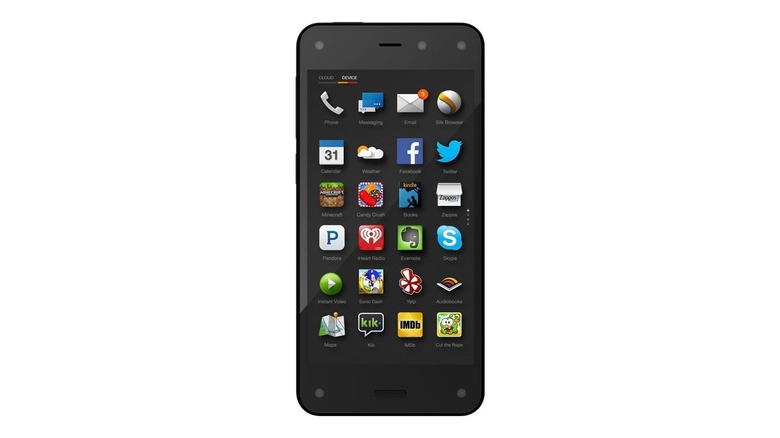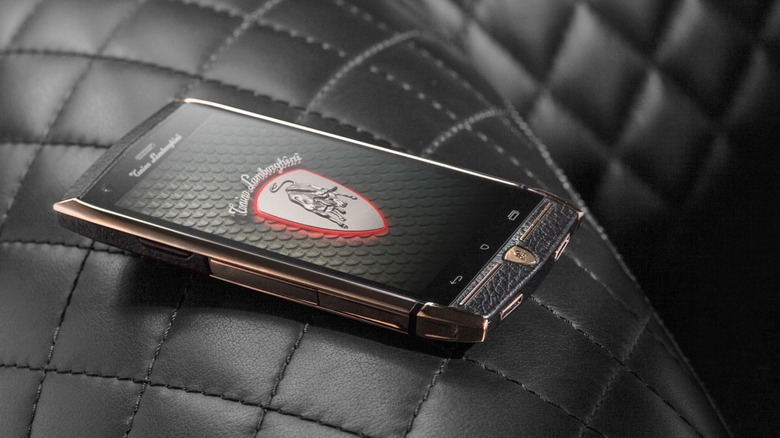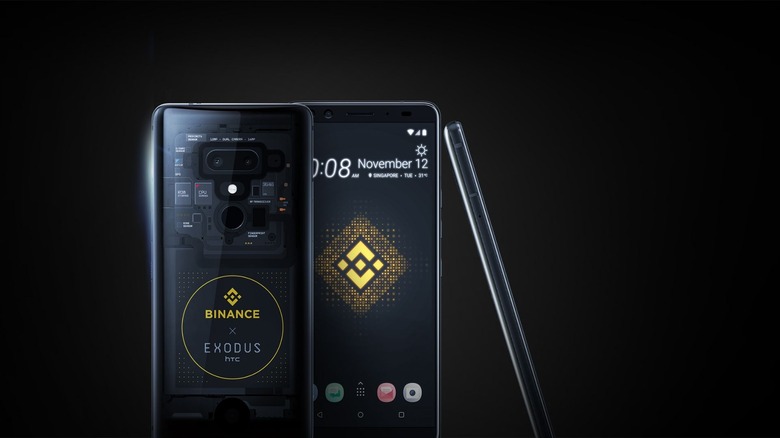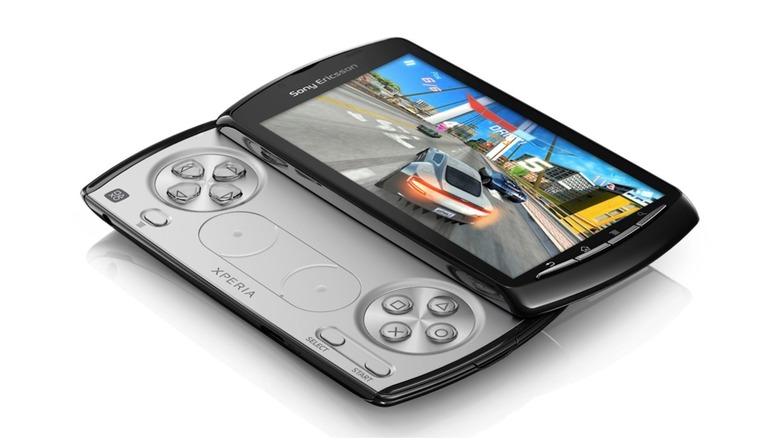The Coca-Cola Phone And The 9 Weirdest Android Devices Ever Made
Ever since smartphones with a large, touchscreen display took hold of the market, choosing one has been relatively easy. Modern smartphones tend to look the same, and many people pick a final option based on the phone's internal specs rather than how it looks.
If you asked a random person whether they could name the current smartphone lines from Samsung, Google, or Apple, they'd probably be able to name at least a few. But if you asked whether they believed that a KFC-branded smartphone existed or that you could buy a Lamborghini 88 Tauri smartphone for a stunning $6,000, they'd probably think you were trolling them.
Believe it or not, these do exist — and there are plenty of other weird Android devices that never seemed to gain popularity, along with a few special edition phones based on current pop culture. Some of these unique Android phones are from popular companies like OnePlus, Amazon, Huawei, and realme. Here are the weirdest Android devices ever made, starting with the Coca-Cola phone.
realme 10 Pro 5G Coca-Cola Edition
If you're a Coca-Cola superfan, Chinese smartphone maker realme released a special Coca-Cola Edition of its 10 Pro 5G smartphone. The phone's internal specs are identical to the 10 Pro 5G, but the Coca-Cola Edition comes with unique software features, an 80s Cola filter for the camera, and a Matte Imitation Metal design that's reminiscent of an actual can of Coke.
Inside the Coca-Cola Edition 10 Pro, you'll find a Snapdragon 695 5G chipset with an Adreno 619 GPU, a 5,000 mAh battery, 8 gigabytes of RAM, and 128 gigabytes of UFS 2.2 storage. The phone runs realme's proprietary UI 4.0 based on Android 13, and supports Wi-Fi 5, Bluetooth 5.1, and 33W SUPERVOOC charging via a USB-C port.
The 6.72-inch screen features a 1080 x 2400 resolution, 120Hz refresh rate, 240Hz touch sampling rate, and 1-millimeter ultra-slim side bezels. There's a 16-megapixel front camera and a 108-megapixel rear camera equipped with a special 80s Cola filter for unique photo opportunities, along with a shutter that makes a bottle-opening sound when it's opened. In addition to the one-of-a-kind shutter sound, realme's Coca-Cola phone shows off specially designed app icons and displays a fizzing bubbles animation when it's charging or when you get notifications. And instead of a boring, traditional ringtone, you'll hear a classic Coca-Cola ringtone whenever someone calls you.
OPPO F11 Pro Marvel's Avengers Limited Edition
Alongside the launch of the popular movie "Avengers: Endgame," OPPO released a limited edition F11 Pro Avengers smartphone. According to a press release from OPPO, its Avengers smartphone sold out in an hour. While the phone retailed for about $400 when it originally launched, you'd be pressed to find one for that price now.
The internal specs for this Avengers edition are similar to the non-Avengers F11 Pro. Under the hood, you'll find an eight-core MediaTek Helio P70 processor, 6 gigabytes of RAM, 128 gigabytes of storage (expandable up to 256 gigabytes with a microSD card), a 4,000 mAh battery, and the Android 9.0 (Pie) operating system with ColorOS 6.0. Then, there's a 6.5-inch screen with a 2340 x 1080 resolution.
So what makes this phone Avengers-themed? It's all in the design. The phone itself is primarily a dark blue color with a partial Avengers symbol popping out in red. You can also find an Avengers logo above the camera array, and the front-facing camera mechanically raises when you want to take a selfie. Spec-wise, there's a 48-megapixel main rear camera, a 5-megapixel secondary rear camera, and a 16-megapixel front camera. The phone's default wallpaper sports yet another Avengers logo, as well as the special edition phone case and collectible coin inside the phone's box. On the back of the special edition phone case, there's a circular Captain America shield that doubles as a finger holder and a kickstand.
OnePlus 8T Cyberpunk 2077 edition
The first thing you'd notice about the Cyberpunk 2077 edition of the OnePlus 8T is the unique packaging. Rather than simply arriving in a traditional smartphone box, OnePlus put this Cyberpunk edition phone in action-figure-style packaging. Then, you'd find a set of collectible metal pins with imagery from the video game, a charger with the Cyberpunk 2077 logo, and the same bright yellow color throughout the phone's packaging and design. Then, there's a specially designed Cyberpunk 2077 protective case, but the phone looks great with or without it.
The yellow packaging aesthetic is beautiful, but OnePlus also brought the trademark industrial design from Cyberpunk 2077 to this smartphone. The phone's camera array stretches all the way across the phone's back horizontally — a redesign choice made by OnePlus to separate this limited edition product from the rest. Instead of the signature red from OnePlus, you'll find Cyberpunk yellow within the phone's custom software UI.
As far as non-software specs go, the Cyberpunk 2077 edition is identical to the OnePlus 8T. The 6.55-inch Fluid AMOLED display has a 2400 x 1080 resolution, 120Hz refresh rate, and a punch-hole front-facing camera. Then, there's a 48-megapixel main rear camera with a Sony IMX586 sensor, along with 8 gigabytes of RAM, 128 gigabytes of UFS 3.1 storage, and a Qualcomm Snapdragon 865 processor with a Snapdragon X55 5G modem and an Adreno 650 GPU.
KFC Huawei 7 Plus
The KFC Huawei 7 Plus was made to celebrate the 30-year anniversary of Kentucky Fried Chicken entering China. When you flip the phone over, the Colonel — the iconic mascot of the KFC brand — is laser-carved into the back. Under the Colonel, you'll see the year 1987, which is the year KFC was first sold in China.
The Kentucky Super app is also pre-installed and comes with 100,000 K dollars, which is the restaurant's digital currency. Users can then exchange this in-app currency for actual items at KFC locations. The KFC phone also lets users create music playlists and share them inside a KFC restaurant using the pre-installed KFC-branded music app.
As far as specs go, there's nothing super impressive about the KFC phone. But let's be honest, if you're buying this phone, you're buying it for the Colonel embossed on the back. The phone has a 5.5-inch screen, a 3,020 mAh battery, a Snapdragon 425 processor, and comes with only 3 gigabytes of RAM and 32 gigabytes of storage (expandable up to 128 gigabytes via a microSD card).
Pepsi Phone P1s
A Coca-Cola phone is currently being produced by realme, but at one point, there was also a Pepsi Phone, too. The Pepsi Phone P1s was part of a crowdfunding campaign in 2015, and early backers received an exclusive blue version of the phone. For everyone else, the phone came with a Pepsi logo on the back and as wallpaper.
For only $110 at the time, the Pepsi Phone P1s had decent specs. The phone sports a 5.5-inch 2.5D screen with a 1080-pixel resolution. Inside, there's an octa-core 1.7GHz mediaTek MT6592 chipset, 2 gigabytes of RAM, 16 gigabytes of internal storage (expandable with a microSD card), a 3,000 mAh battery, and dual SIM card slots. For cameras, there's a 13-megapixel main camera in the back as well as a 5-megapixel front camera. The phone ran Android 5.1 (Lollipop) right out of the box, with an overlay called dido OS 6.1.
HTC First
The HTC First smartphone is equipped with a content-rich home screen that puts Facebook in the spotlight. Though it's commonly referred to as the Facebook phone, it's actually not the only Facebook phone, or even the first. In 2011, HTC and Facebook paired up to release the Salsa and ChaCha smartphones — neither of which took off. Two years later, the company tried again with the HTC First. Unfortunately, this Facebook phone ultimately failed, just like the other two. Was the HTC First a bad smartphone? Not particularly, but it was up against some pretty fierce competition from Samsung and Apple. Although Facebook was quite popular back then, it wasn't popular enough to entice people away from flagships from Samsung and Apple.
The 4.3-inch Super LCD display had a 720-pixel resolution, 341 ppi, and curved edges. There was also a 2,000 mAh fixed battery, support for 4G and Bluetooth 4.0, a 5-megapixel rear camera with LED flash, and a 1.6-megapixel front camera. Inside, you'd find a Qualcomm Snapdragon 400 8930AA dual-core processor, 1 gigabyte of RAM, and 16 gigabytes of storage with no microSD card slot to add extra.
Less than a month after the HTC First was released, AT&T began dropping the subsidy price to only $0.99 in an attempt to move units because they weren't selling. The HTC First was in competition with Samsung's Galaxy S4, Apple's iPhone 5S, and even HTC's One smartphone, and all of these phones offered more well-balanced specs for their price.
Amazon Fire Phone
When Amazon first put its hand into the smartphone ring with the Fire phone, people were anxiously anticipating the device's release. The phone promised a lot, including computational photography, an ambitious UI, and the convenience of having Prime in your pocket. So why isn't there an Amazon Fire phone released every year just like flagships from Google, Samsung, and Apple? Because despite some pretty awesome features, it wasn't a great device overall.
Powering everything inside is a quad-core Qualcomm Snapdragon 800 processor — similar to the Kindle Fire HDX tablets at the time — along with Adreno 330 graphics, storage options of 32 or 64 gigabytes, unlimited cloud storage for photos, 2 gigabytes of RAM, and a 2,400 mAh battery. Then, the Fire Phone's 4.7-inch LCD screen featured a 1280 x 720 resolution and had a quartet of low-power, ultra-wide cameras surrounding it for face tracking. In addition to these four smaller cameras, there was a 2.1-megapixel front camera and a 13-megapixel main rear camera.
Though the Amazon Fire Phone did ultimately fail, it functioned quite well when it came to buying and selling things on Amazon. One of the phone's best features was product recognition, though it didn't work all the time. You could show the Fire Phone a book, CD, or DVD cover, and it would bring up the listing for the item. This feature didn't always work well for household items that didn't have a clear title or author.
Tonino Lamborghini 88 Tauri
Paying $1,000 for a modern smartphone isn't strange — in fact, it's kind of the norm. Sure, there are also smartphones out there for only $100, as well as options that soar past $2,000. The Tonino Lamborghini 88 Tauri smartphone blows the price of other smartphones out of the water, with a shocking price tag of $6,000. And yes, this phone is made by and branded by Lamborghini.
SlashGear noted that the phone's design came off as a bit gaudy. The phone's outer casing consisted of 0.5mm-thick leather and stainless steel components. All of the metal pieces were colored with Physical Vapour Deposition (PVD), which was meant to help the phone stand up well to normal wear and tear.
The 88 Tauri came with a 5-inch display with full HD resolution, an 8-megapixel front camera, and a 20-megapixel main rear camera, which was considered a massive camera at the time the phone was released. Inside, everything was powered by a 2.3GHz quad-core Qualcomm Snapdragon 801 processor and 3 gigabytes of RAM. The phone also had two-SIM functionality and worked with both 3G and 4G networks.
HTC EXODUS 1 - Binance Edition
The HTC EXODUS 1 – Binance Edition was the world's first blockchain smartphone that allows users to manage their Binance Coin (BNB) through the native Zion Vault crypto wallet app, which uses the Trusted Execution Environment (TEE) to protect your data and private keys. The Zion app integrates with Binance DEX, which allows users to trade on the decentralized exchange directly from the smartphone.
Unlike most app-based wallets that are connected to the internet and prone to attacks from malware and hacking attempts, the EXODUS 1 combines its hardware and software technologies to protect you on both fronts. HTC's Binance Edition smartphone essentially acts as a cryptocurrency hardware wallet, storing your digital assets locally on your smartphone rather than solely through a digital wallet.
In addition to acting as a hardware wallet that allows users to own their own private keys, the HTC EXODUS 1 also had some decent internal specs, making it a great smartphone, as well. Inside is a 3,500 mAh battery, a Qualcomm Snapdragon 845 processor, 6 gigabytes of RAM, and 128 gigabytes of UFS 2.1 storage. The phone has an IP68 waterproof rating, a 12-megapixel and 16-megapixel dual main camera in the back, an 8-megapixel front camera, and a 6-inch Quad HD+ display. Then, to tie everything together, the Binance Edition features a specially designed wallpaper and back phone cover.
Sony Ericsson Xperia PLAY
There may not be an Xbox phone out there — at least, not yet — but there is a PlayStation phone. Sony's Ericsson XPERIA Play smartphone launched around the same time as the Sony PSP Go, and honestly, neither phone impressed the public very much. The gamepad controls worked well, and the idea of playing PS One titles on the go was great, but when SlashGear reviewed the XPERIA Play, the hardware and amount of available games were lacking.
The phone ran Android 2.3.3 (Gingerbread) with Sony Ericsson's custom UI on top and had a 4-inch display with a resolution of 854 x 480 pixels. Beneath the display, the XPERIA Play was equipped with a single-core 1GHz Qualcomm Snapdragon MSM8255 processor, Adreno 205 graphics, 512 megabytes of RAM, 400 megabytes of internal storage (with an expandable microSD card up to 8 gigabytes), and a 1,500 mAh battery. Then, there's a front-facing VGA resolution camera and a 5-megapixel main camera on the back.
Sony Ericsson's XPERIA Play phone may not have been the best in many categories, but the gaming controls prompted the most public interest. There were left and right gaming shoulder keys, and you could slide up the spring-loaded display to reveal a D-pad, PlayStation-style face buttons — triangle, square, circle, and cross — a menu button, and two touch-sensitive analog controls to mimic that of the DualShock controller. Opening the controller slide automatically shifted the phone into gaming mode. Then, Sony Ericsson incorporated a gaming focus within the phone's software as well. Sony Ericsson The company added a PlayStation game carousel widget, various media controls, and a UI skin with blues and transparent effects rather than Android Gingerbread's black and lime green colors.
